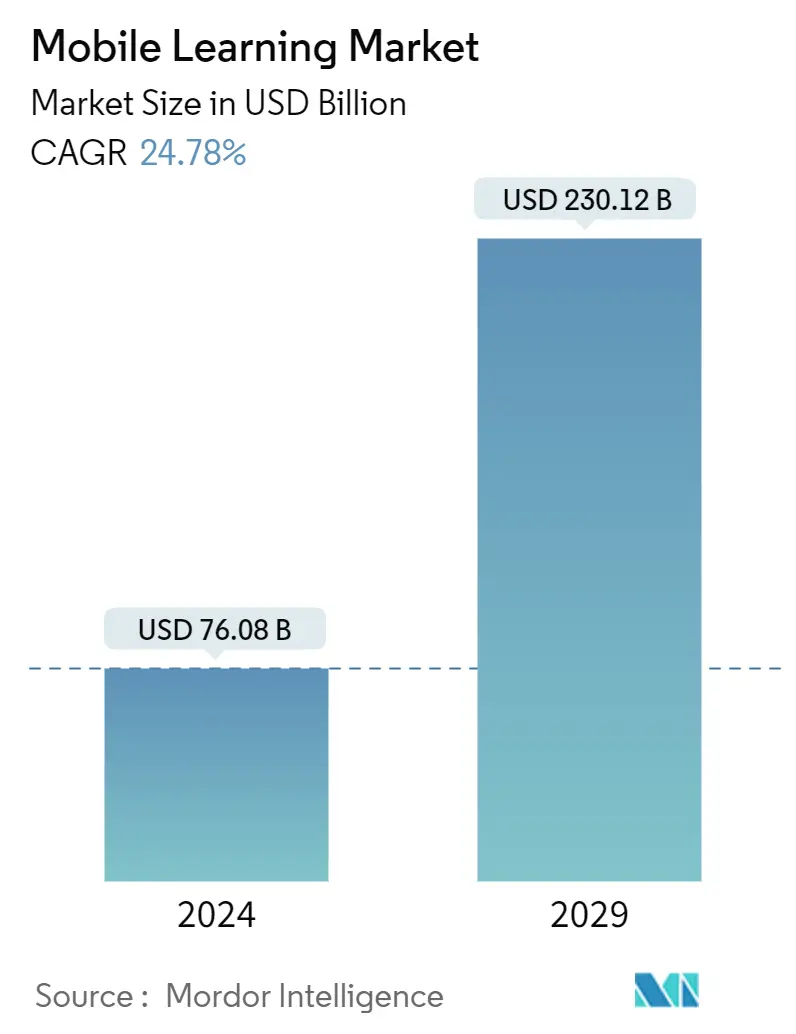Market Size of Mobile Learning Industry

| Study Period | 2019 - 2029 |
| Market Size (2024) | USD 76.08 Billion |
| Market Size (2029) | USD 230.12 Billion |
| CAGR (2024 - 2029) | 24.78 % |
| Fastest Growing Market | Asia Pacific |
| Largest Market | North America |
Major Players
*Disclaimer: Major Players sorted in no particular order |
Mobile Learning Market Analysis
The Mobile Learning Market size is estimated at USD 76.08 billion in 2024, and is expected to reach USD 230.12 billion by 2029, growing at a CAGR of 24.78% during the forecast period (2024-2029).
The rapid adoption of electronic devices in educational institutions, increasing investment in information technology, and growing adoption of Bring Your Own Device (BYOD) culture are some of the major factors driving the growth of the mobile learning market.
- The recent advancements in digital learning solutions owing to the higher penetration of mobile devices have empowered learners with access to material, irrespective of their location, by erasing boundaries and introducing interactive means through which the overall learning experience has been enhanced. Moreover, the information is being presented in a more effective way by using numerous types of digital media, which helps in better understanding and retention of concepts.
- According to a recent HP India report, 63% of respondents in the country believed that digital learning is much more effective in fuelling their children's creative thinking, and 57% of the respondents believed that experiential learning could enable better comprehension. Additionally, owing to this reason, parents are willing to spend on learning apps for their child's education, which is expected to drive the market.
- Schools and training centers are also moving from their traditional blackboard approach to integrating smart technology into learning environments. At the university level, institutions are adopting innovative methods, such as smart learning, to provide alternative pathways and opportunities for students to develop relevant and valuable skills in line with industry requirements.
- A survey conducted by Project Tomorrow (a non-profit organization) worldwide on digital learning with a sample size of more than 4 lakh stakeholders revealed that digital learning led to an increase in student engagement, enabled teachers to introduce new forms of learning styles, and reduced the overall time taken by students to digest information. Additionally, according to Promethean's recent study, the majority of teachers believe that educational technology accelerates learning in their classrooms (82%).
- With the proliferation of mobile devices, such as smartphones, laptops, and tablets, the BYOD trend is increasingly growing in schools, transforming the way students learn and how, where, and when they consume educational information.
Mobile Learning Industry Segmentation
Mobile learning is learning by accessing content via the internet or network using personal mobile electronic devices. It is a form of distance education with flexibility where users can learn at their own speed and convenience.
The mobile learning market is segmented by software (e-books, interactive assessment, mobile and video-based courseware), application (in-class learning, corporate learning, simulation-based learning, online-on-the-job training, independent learning), end user (academic institutions, corporate companies), and geography (North America (United States, Canada), Europe (Germany, UK, France, Spain, and Rest of Europe), Asia-Pacific (China, Japan, India, Australia, and Rest of Asia-Pacific), and Latin America (Brazil, Mexico, Argentina, and Rest of Latin America), and Middle East & Africa (UAE, Saudi Arabia, South Africa, and Rest of MEA).
The market sizes and forecasts are provided in terms of value in USD for all the above segments.
| Software | |
| E-Books | |
| Interactive Assessment | |
| Mobile and Video-Based Courseware | |
| Other Softwares |
| Application | |
| In-Class Learning | |
| Corporate Learning | |
| Simulation-Based Learning | |
| Online-on-the Job Training | |
| Independent Learning |
| End User | |
| Academic Learning | |
| Corporate Learning |
| Geography*** | ||||||
| ||||||
| ||||||
| ||||||
| ||||||
|
Mobile Learning Market Size Summary
The mobile learning market is experiencing significant growth, driven by the increasing adoption of electronic devices in educational settings, investments in information technology, and the rise of the Bring Your Own Device (BYOD) culture. This sector is characterized by the integration of digital learning solutions that enhance accessibility and interactivity, allowing learners to engage with educational content from any location. The shift from traditional teaching methods to smart technology in schools and universities is fostering a more engaging and effective learning environment. This transformation is supported by the growing recognition of digital and experiential learning as effective tools for enhancing creativity and comprehension, leading to increased investment in learning apps and digital platforms.
In the corporate sector, mobile learning is becoming a vital component of training and development, with organizations leveraging technology-aided learning to boost productivity and employee engagement. The flexibility of mobile learning solutions, such as MOOCs, allows employees to learn at their own pace and convenience, reducing training costs and enhancing skill acquisition. The Asia Pacific region is poised to make a substantial contribution to the market's growth, driven by rapid internet expansion and the widespread use of mobile devices. The competitive landscape of the mobile learning market is dominated by major players, but mid-size and smaller companies are also gaining traction through strategic partnerships and technological innovations. These developments are expected to further propel the market's expansion in the coming years.
Mobile Learning Market Size - Table of Contents
-
1. MARKET INSIGHTS
-
1.1 Market Overview
-
1.2 Industry Stakeholder Analysis
-
1.3 Industry Attractiveness - Porter's Five Forces Analysis
-
1.3.1 Bargaining Power of Suppliers
-
1.3.2 Bargaining Power of Consumers
-
1.3.3 Threat of New Entrants
-
1.3.4 Threat of Substitute Products
-
1.3.5 Intensity of Competitive Rivalry
-
-
-
2. MARKET SEGMENTATION
-
2.1 Software
-
2.1.1 E-Books
-
2.1.2 Interactive Assessment
-
2.1.3 Mobile and Video-Based Courseware
-
2.1.4 Other Softwares
-
-
2.2 Application
-
2.2.1 In-Class Learning
-
2.2.2 Corporate Learning
-
2.2.3 Simulation-Based Learning
-
2.2.4 Online-on-the Job Training
-
2.2.5 Independent Learning
-
-
2.3 End User
-
2.3.1 Academic Learning
-
2.3.2 Corporate Learning
-
-
2.4 Geography***
-
2.4.1 North America
-
2.4.1.1 United States
-
2.4.1.2 Canada
-
-
2.4.2 Europe
-
2.4.2.1 Germany
-
2.4.2.2 United Kingdom
-
2.4.2.3 France
-
2.4.2.4 Spain
-
-
2.4.3 Asia
-
2.4.3.1 China
-
2.4.3.2 Japan
-
2.4.3.3 India
-
2.4.3.4 Australia and New Zealand
-
-
2.4.4 Latin America
-
2.4.4.1 Brazil
-
2.4.4.2 Mexico
-
2.4.4.3 Argentina
-
-
2.4.5 Middle East and Africa
-
2.4.5.1 United Arab Emirates
-
2.4.5.2 Saudi Arabia
-
2.4.5.3 South Africa
-
-
-
Mobile Learning Market Size FAQs
How big is the Mobile Learning Market?
The Mobile Learning Market size is expected to reach USD 76.08 billion in 2024 and grow at a CAGR of 24.78% to reach USD 230.12 billion by 2029.
What is the current Mobile Learning Market size?
In 2024, the Mobile Learning Market size is expected to reach USD 76.08 billion.

